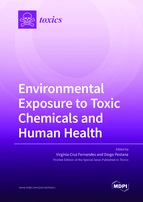Environmental Exposure to Toxic Chemicals and Human Health
A special issue of Toxics (ISSN 2305-6304). This special issue belongs to the section "Exposome Analysis and Risk Assessment".
Deadline for manuscript submissions: closed (20 December 2022) | Viewed by 32693
Special Issue Editors
Interests: analytical chemistry; chromatography; contaminants: pesticides; flame retardants, PCBs; environmental, food and human samples; monitoring and biomonitoring
Special Issues, Collections and Topics in MDPI journals
Interests: basic, clinical and population studies; diet and environmental exposure to toxic chemicals; endocrine disruptors; human biomonitoring; human health; obesity and metabolic-related pathologies; risk–benefit analysis
Special Issues, Collections and Topics in MDPI journals
Special Issue Information
Dear Colleagues,
Human and industrial activities generate various forms of residual wastes and by-products in a solid, liquid or gaseous state. Waste generation starts with simple processes such as living, eating and breathing. Managing waste and minimizing associated environmental impacts have become more challenging as worldwide populations and economies continue to grow. Once these hazardous chemicals are present in the environment, people can become exposed to them. Human health can be influenced by many factors, including exposure to physical, chemical, biological, and radiological contaminants in the environment.
This Special Issue will comprise research articles, short communications and reviews related to all the aspects related to the environmental exposure to multiple toxic chemicals and human health. Manuscripts dedicated to toxicology, biomonitoring, exposure and risk assessment and new analytical approaches in human matrices are welcome. Furthermore, other aspects such as endocrine disruptors, determinants of exposure and effect, as well as contaminated sites and occupational exposure will also be embraced.
As such, with this Special Issue, we intend to collect a broad overview of the environmental exposure to several toxic chemicals (e.g., heavy metals, persistent organic pollutants, micro(nano)plastics, plastic-related chemicals) and human health.
Main Goals:
Evaluate the extent to which people are exposed to contaminants in the air, water, soil, sediments and through food ingestion; how these exposures affect human health; and what levels of exposure are harmful.
Prof. Dr. Virgínia Cruz Fernandes
Prof. Dr. Diogo Pestana
Guest Editors
Manuscript Submission Information
Manuscripts should be submitted online at www.mdpi.com by registering and logging in to this website. Once you are registered, click here to go to the submission form. Manuscripts can be submitted until the deadline. All submissions that pass pre-check are peer-reviewed. Accepted papers will be published continuously in the journal (as soon as accepted) and will be listed together on the special issue website. Research articles, review articles as well as short communications are invited. For planned papers, a title and short abstract (about 100 words) can be sent to the Editorial Office for announcement on this website.
Submitted manuscripts should not have been published previously, nor be under consideration for publication elsewhere (except conference proceedings papers). All manuscripts are thoroughly refereed through a single-blind peer-review process. A guide for authors and other relevant information for submission of manuscripts is available on the Instructions for Authors page. Toxics is an international peer-reviewed open access monthly journal published by MDPI.
Please visit the Instructions for Authors page before submitting a manuscript. The Article Processing Charge (APC) for publication in this open access journal is 2600 CHF (Swiss Francs). Submitted papers should be well formatted and use good English. Authors may use MDPI's English editing service prior to publication or during author revisions.
Keywords
- environmental exposure
- toxic chemicals
- emerging pollutants
- micro(nano)plastics
- analytical methods
- biomonitoring
- human health
- risk assessment
Related Special Issue
- Environmental Exposure to Toxic Chemicals and Human Health II in Toxics (4 articles)








